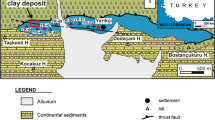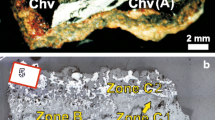Abstract
Clay minerals from the three principal kinds of zeolitic sediments from the type area for zeolite facies alteration, the Triassic Murihiku Supergroup, Southland, New Zealand, have been studied by TEM. Bentonitic tuff consists largely of smectite and heulandite with minor illite; they occur as replacements of glass shards and are inferred to be direct alteration products of tuff alteration. Both analcime- and laumontite-rich tuffs contain chlorite, illite and mixed-layer illite-chlorite, including 1∶1 mixed-layer sequences. Subhedral to euhedral phyllosilicate crystal shapes and other textural features imply that phyllosilicates crystallized from solution derived in part by dissolution of precursor smectite. Intralayer transitions involving illite and chlorite are inferred to be products of crystallization rather than direct alteration and replacement. Petrographically similar bentonitic and analcimized tuffs overlap each other in the stratigraphic section, supporting earlier observations that there is no systematic change in smectite relative to the illite plus chlorite derived from smectite in sections up to 8.5 km thick. The data imply that smectite may be metastable relative to illite plus chlorite. Permeability and fluid chemistry are inferred to be as significant as temperature in promoting reactions in clay minerals as well as zeolites during burial metamorphism.
Similar content being viewed by others
References
Ahn JH, Peacor DR (1985) Transmission electron microscopic study of diagenetic chlorite in Gulf Coast argillaceous sediments. Clays Clay Minerals 33:228–236
Ahn JH, Peacor DR (1986) Transmission and analytical electron microscopy of the smectite-to-illite transition. Clays Clay Minerals 34:165–179
Ahn JH, Peacor DR (1987) Transmission electron microscopic study of the diagenesis of kaolinite in Gulf Coast argillaceous sediments. Proc Int Clay Conf, Denver 1985:151–157
Boles JR (1971) Synthesis of analcime from natural heulandite and clinoptilolite. Am Mineral 56:1724–1734
Boles JR (1972) Composition, optical properties, cell dimensions, and thermal stability of some heulandite group zeolites. Am Mineral 57:1463–1493
Boles JR, Coombs DS (1975) Mineral reactions in zeolitic Triassic tuff, Hokonui Hills, New Zealand. Geol Soc Amer Bull 86:163–173
Boles JR, Coombs DS (1977) Zeolite facies alteration of sandstones in the Southland Syncline, New Zealand. Am J Sci 277:982–1012
Cho M, Maruyama S, Liou JG (1986) The stability of heulandite in the system CaAl2Si2O8-SiO2-H2O. Abstracts with Program, 14th General Meeting, International Mineralogical Assoc, 13–18 July 1986. Stanford Univ, Calif: p 76
Coombs DS (1954) The nature and alteration of some Triassic sediments from Southland, New Zealand. Trans Royal Soc New Zealand 82:65–109
Coombs DS (1961) Some recent work on the lower grades of metamorphism. Australian J Sci 24:203–215
Coombs DS (1965) Sedimentary analcime rocks and sodium-rich gneisses. Mineral Mag 34:144–158
Coombs DS, Campbell JD, McKeller IC, Landis CA, Bishop DG (1976) Regional geology of southern part of South Island, New Zealand Geosyncline. 25th International Geological Congress, Excursion Guide No. 59c: 36p
Coombs DS, Ellis AJ, Fyfe WS, Taylor AM (1959) The zeolite facies, with comments on the interpretation of hydrothermal syntheses. Geochim Cosmochim Acta 17:53–107
Curtis CD, Hughes CR, Whiteman JA, Whittle CK (1985) Compositional variation within some sedimentary chlorite and some comments on their origin. Mineral Mag 49:375–386
Eberl D (1978) Reaction series for dioctahedral smectite. Clays Clay Minerals 26:327–340
Eggleton RA, Banfield JF (1985) The alteration of granitic biotite to chlorite. Am Mineral 70:902–910
Hower J, Eslinger E, Hower ME, Perry EA (1976) Mechanism of burial metamorphism of argillaceous sedimen: 1. Mineralogical and chemical evidence. Geol Soc Amer Bull 87:725–737
Iijima S, Buseck PR (1978) Experimental study of disordered mica structures by high-resolution electron microscopy. Acta Crystallogr A34:709–719
Iijima S, Zhu J (1982) Electron microscopy of a muscovite-biotite interface. Am Mineral 67:1195–1205
Lee JH, Peacor DR (1985) Ordered 1∶1 interstratification of illite and chlorite: a transmission and analytical electron microscopy study. Clays Clay Minerals 33:463–467
Lee JH, Peacor DR, Lewis DD, Wintsch RP (1984) Chlorite-illite/muscovite interlayered and interstratified crystals: a TEM/STEM study. Contrib Mineral Petrol 88:372–385
Liou JG (1971) Analcime equilibria. Lithos 4:389–402
McKellar IC (1966) Sheet 25, Dunedin (1st ed.), Geological Map of New Zealand 1∶250000. Department of Scientific and Industrial Research, Wellington, New Zealand
Olives BJ, Amouric M, de Fouquet C, Baronnet A (1983) Interlayering and interlayer slip in biotite as seen by HRTEM. Am Mineral 68:754–758
Perry E, Hower J (1970) Burial diagenesis in Gulf Coast pelitic sediments. Clays Clay Minerals 18:165–177
Schreyer W, Medenbach O, Abraham K, Bergert W, Muller WF (1982) Kulkeite, a new metamorphic mineral∶ordered 1∶1 chlorite/talc mixed-layer. Contrib Mineral Petrol 80:103–109
Veblen DR (1983) Microstructures and mixed-layering in intergrown wonesite, chlorite, talc, biotite, and kaolinite. Am Mineral 68:566–580
Veblen DR, Buseck PR (1980) Microstructures and reaction mechanisms in biopyriboles. Am Mineral 65:599–623
Veblen DR, Ferry JM (1983) A TEM study of the biotite-chlorite reaction and comparison with petrologic observations. Am Mineral 68:1160–1168
Weaver CE, Beck KC (1971) Clay-water diagenesis during burial: how mud becomes gneiss. Geol Soc Amer Spec Paper 134:96p
Yau YC, Anovitz LM, Essene EJ, Peacor EJ (1984) Phlogopitechlorite reactions during retrograde reaction in the Marble Formation, Franklin, New Jersey. Contrib Mineral Petrol 88:299–308
Yau YC, Peacor DR (1987) Smectite-to-illite reactions in Salton Sea shales: a transmission and analytical electron microscopy study. J Sed Petrol 57:335–343
Yau YC, Peacor DR, Essene EJ, Lee JH, Kuo LC, Cosca MA (1987) Hydrothermal treatment of smectite, illite, and basalt to 460° C: comparison of natural with hydrothermally formed clay minerals. Clays Clay Minerals 35:241–250
Yau YC, Peacor DR, McDowell SD (1984) TEM/AEM study of chlorite diagenesis in well I.I.D. No. 2 in Salton Sea geothermal field, California. Progr Abstr 21st Ann Mtg, Clay Minerals Soc 1984: p 120
Zen E (1961) The zeolite facies: an interpretation. Am J Sci 259:401–409
Zen E (1974) Burial metamorphism. Can Mineral 12:445–455
Author information
Authors and Affiliations
Additional information
Contribution No. 436, from The Mineralogical Laboratory, Department of Geological Sciences, The University of Michigan, Ann Arbor, Michigan 48109
Rights and permissions
About this article
Cite this article
Ahn, J.H., Peacor, D.R. & Coombs, D.S. Formation mechanisms of illite, chlorite and mixed-layer illite-chlorite in Triassic volcanogenic sediments from the Southland Syncline, New Zealand. Contr. Mineral. and Petrol. 99, 82–89 (1988). https://doi.org/10.1007/BF00399368
Received:
Accepted:
Issue Date:
DOI: https://doi.org/10.1007/BF00399368




